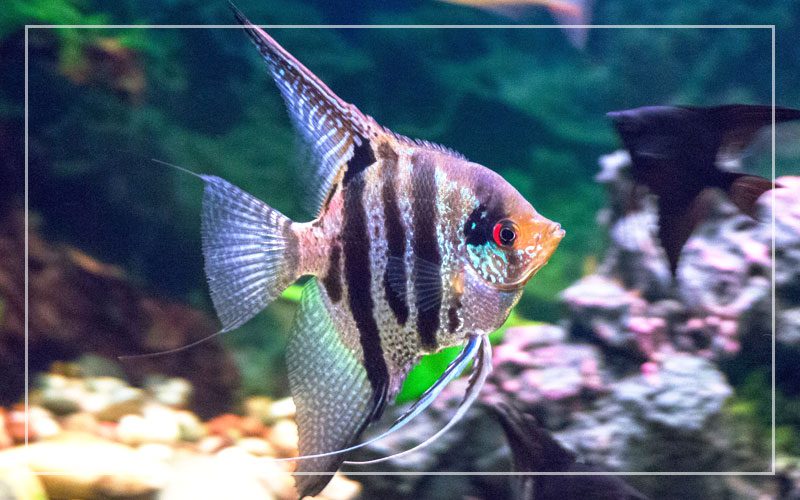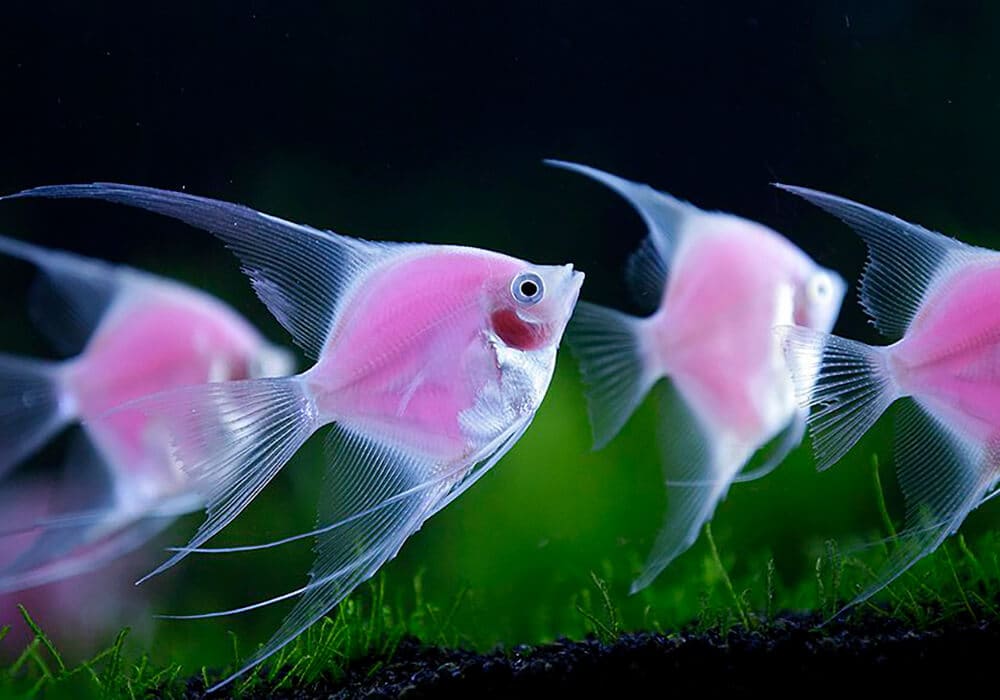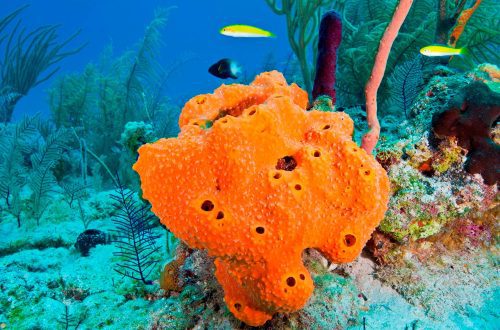
Angelfish: its types, care, maintenance, compatibility
The angelfish is often referred to as the “angelfish”. And this is not surprising, because she really looks like an unearthly creature. Therefore, it is quite understandable that many people dream of acquiring such a miracle. But, of course, before you buy a scalar, you need to learn more about it.
Contents
Angelfish: its types
So, Let’s start with the definition of the type scalars:
- Fish scalaria koi – talking about what it is the scalar that is the most attractive, worth it in the first place mention this particular fish. Looks in terms of structure, it is the same as the rest of the scalars. That is, the body has flattening on the sides, elongated dorsal and anal fins, filiform ventral fins, small scales. The size also standard: 15 cm long and 25 to 30 cm high with fins. But as for the color, here is the game the colors are really amazing. Basic the tone of this fish is white, but on this black strokes are picturesquely scattered on the background. There is a big spot on the head, the color of which can be both yellow, and orange or bright red. Interesting observation: the smaller this speck, the more expensive his mistress usually costs. In some areas, for example fins – you can see translucency. In others, the scales glisten bewitchingly. This type of scalar was bred artificially.
- Black scalar – also known as “scalar Ludwig”. The last name was given in honor of the Ludwig family of Detroit, which brought out this species. Ideal considered the individual who has neither one colored spot or shiny plots. However, to bring such pure black fish is quite difficult, only experienced breeders can do this. By the way, the red rim around the eyes is all same is allowed. However, it is quite possible become the owner of a veiled scalar – it is a subspecies of black. On her scales you can notice a slight pattern.
- Blue fish – or “Philippine angelfish” – it is distinguished by a delicate blue color as body as a whole, and fins. It is believed that it is especially advantageous to place such fish in an aquarium, where living plants live – they are together look remarkably effective. It turned out such beauty due to crossing platinum fish with others. В the result was a mass varieties of blue scalar, the most popular of which is pinoy. Pinoy These are spotted blue fish.
- Red variety – also effectively named “Red Devil” is, in fact, koi followers. Breeders carefully tried to choose those fish that have a bright spot it was larger – and it turned out red devil. It is noteworthy that during life color intensity in fish is changing. It is believed that the brightest they appear when it comes to the end of their first year of life. Yes, and yourself hosts use some trick – treat pets with special food, which makes the color more intense. The most expensive is that scalar, in which no other shades are observed, except for red.
- Gold angelfish – its golden scales are often cast with mother-of-pearl, which is why the fish seems sometimes white-golden. Interesting, What does looking at from different angles various effects thanks to whimsical overflow. But the fins, as a rule, transparent and shorter than representatives of other species. However, otherwise, the dimensions of this fish large. Stripes are usually not allowed, however, on the dorsal plumage they can be present. It is believed, that these scalars are one of the most unpretentious.
- Angelfish (Scalare) white – pure white fish, which in ideally, there should not even be stripes. Her fins are completely without color, transparent. Some confuse whites angelfish with albinos, however, distinguish they are not difficult actually – you need take a look at the eyes. Namely, to whether there is a rim around the eyes – albinos have it, painted in Red color. And just his white fish Dont Have. However, it should be noted that white angelfish can have silver overflows.
- Angelfish (Scalare) Altum is an unusual species that breeds in the wild and at home so far this phenomenon not practiced. It costs a lot because inhabits only in the Orinoco basin. Altum more taller than the rest of the fish – he can even reach 50 cm! On the muzzle you can observe a depression, because of which the muzzle of the fish protrudes strongly. Scales are smaller than others scalars. As for the drawing, vertical stripes can be seen reddish tone, as well as shaded stripes that, by the way, do not meet in other species. Enough demanding appearance, as it is subject to stress and require a lot of space.
- Marble scalars – but they are easier to keep the rest, so it’s better for beginners look at these scalars. They small, but a distinctive feature is a silver-black color, which really resembles the color marble. Find two individuals with the same drawing will not work – this is interesting such fish.
- Glowing pink scalar – purely artificial a product that captivates from the first the same look. However, there is such the fish is infrequent, and costs, accordingly, a lot.
Maintenance of angelfish and care behind them: what you need to know
So, what are the conditions for keeping scalars you can note?
- Angelfish are so easily adapted to captivity that it is not difficult to keep them. The main thing is to prepare a capacious aquarium. An ideal aquarium is one that reaches a height of at least 45 cm. The volume for a couple should be at least 100 liters.
- Speaking of the number of fish: they are very fond of living in flocks. Perhaps keeping angelfish even in pairs is not a good idea. It is best to purchase 5-6 persons at once. Do not be surprised if one pair is determined, which will dominate and periodically sort things out with others – this is normal for scalars. But they certainly won’t be bored.
- When choosing soil, it is recommended to prefer coarse sand or small pebbles. The fact is that they are ideal for planting plants. Plants, by the way, should be long, densely planted – in this case, the fish have an excellent opportunity to hide from their fellow tribesmen, who are more conflicted. In addition, in their usual natural habitat, these fish are surrounded by a mass of aquatic plants. Scalars swim among them without problems. Plants, by the way, do not damage angelfish, as they do not have a tendency to dig the ground. Fish will also be happy with grottoes and snags.
- Water must certainly be very clean and saturated with air. Therefore, filtration with aeration should be of the highest quality. Experts recommend using external filters, as well as productive type compressors. The water temperature, given the tropical roots of the fish, should not fall below 24 degrees. In principle, any hardness is acceptable, but it is preferable to stop at 5-15 dGH. As for acidity, its level should be neutral or weak – indicators of 6,5-7,5 are considered optimal. And, of course, do not forget that the water must be changed without fail. The frequency of this event is once a week. Each time you need to replace 25-30% of the total volume.
- It is worth purchasing a set of test drops for phosphate and nitrate. And ideally, tests for nitrite, ammonia will also come in handy. The fact is that their increased content leads to the fact that the fish die. By the way, this cause of death is among the most common.
- Bright light for angelfish is not a problem, they tolerate it perfectly. Therefore, it is recommended that when choosing the intensity of lighting, it is not necessary to start from the needs of the fish, but from the needs of the plants.
- As for feeding, there will be no problems with this – the angelfish eats everything with great pleasure. That is, both live, and dry, and frozen food. The soft parts of plants also delight them. The most important thing is that the diet is nutritious and varied, contains vitamins. It is desirable that food stays well on the surface, as these fish prefer to feed in the upper layers. But at the same time, you need to give just such a portion that would be eaten in a few minutes. Red and yellow fish should be given special food containing carotenoids. But it is also not worth taking it as the basis of nutrition – let such food be an addition to the main diet.

Compatibility of scalars with other inhabitants of aquariums
Angelfish (Scalare) – the fish is generally peaceful, however there are certain nuances:
- Most the best neighbors for angelfish are viviparous large fish. That is, the swordsmen, mollies. They also get along great. they are with labyrinth fish – lalius, gourami. Make friends with different types catfish – that is, with thoracatums, corridors, ancistrus.
- Barbusses – not the fish with which the scalar stands settle if you don’t want to spoil the beauty of the latter. A business is that barbs do not have a very good habit, which is biting the pectoral fins of the angelfish. Recall that their pectoral fins filiform – they are easy to bite. And many barbs are fond of this, to unfortunately.
- Despite to a peaceful disposition, scalars sometimes show themselves as predatory fish. They manifest themselves in this way to the small inhabitants of the aquarium, which can “crush”. And especially often this happens during spawning, when it becomes necessary to drive away strangers away from the place where spawning. So, small heracin It is better to keep the fish away from the angelfish.
- But some small fish with angelfish they can still make friends. For example, a flock minors and tetras the heroes of our article are unlikely whether touched.
- No all owners of aquariums think about the compatibility of fish depending on on their conditions of detention. Between so completely in vain. Yes, gold fish and discus, with which, by the way, often want to breed angelfish, can’t stand the temperature at all. which suits scalars.
Reproduction of angelfish: let’s talk about the nuances
Now should tell the main points regarding the breeding of angelfish:
- For First, let’s talk about how to determine gender of these fish. To do this, by the way, is not so simple, because the differences between these fish are not so obvious. However, experts advise look at the head and the general body structure of the fish. Males have more prominent forehead and more slender, than females. Also recommended look at the line of the back, abdomen: girls it is straight, and in boys it is usually looks like a zigzag. However, determining the exact gender becomes more or less possible in 8-12 months, it’s unlikely to work before.
- Females and males must be kept together. The point is that the male ready for fertilization only in that in case it is next to an individual of the opposite sex. By the way, a couple of scalars choose themselves.
- В In principle, spawning can take place in the same aquarium in which the fish live at the usual time. However, it’s always worth be aware that other residents aquarium is not averse to eating caviar. She is left on pebbles, wide leaves – in a word, it will be found not difficult. So it’s better to buy special aquarium for spawning. Requirements to it the following: volume – at least 80 l, and the temperature and hardness are slightly higher, than usual.
- Unnecessarily anxious aquarists should know what from angelfish parents. And their parents very responsible. Before spawning The couple works together to thoroughly clean the future place of “landing” of eggs. BUT after that, the fish ventilate the eggs fins, discard the spoiled ones. You can, perhaps, buy methylene blue – it will prevent the appearance fungus
- After before the larvae appear, better install a filter in the aquarium. Preferably to belong to the airlift type – such a filter will not suck fry. If there are too many fry, it is recommended plant them in different aquariums, so how abundance can lead to poisoning nitrites, ammonia.
Beauty and grace give the scalars the most real aristocratic gloss! They are beautiful, unpretentious, intelligent – what else is needed? It is also worth remembering how long do they live angelfish: with careful care, such a pet can please 10 years, or even more. Ideal aquarium fish! That’s why aquarists love it. for over a hundred years now.





